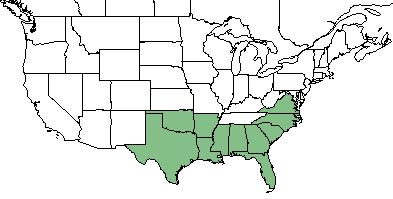Difference between revisions of "Smilax smallii"
(→Distribution) |
(→Taxonomic Notes) |
||
| Line 20: | Line 20: | ||
==Taxonomic Notes== | ==Taxonomic Notes== | ||
| − | Synonym(s): ''S. maritima''<ref name="Weakley 2015"/> | + | Synonym(s): ''S. maritima'';<ref name="Weakley 2015"/> ''S. domingensis''; ''S. lanceolata''<ref name="USDA"/> |
==Description== <!-- Basic life history facts such as annual/perrenial, monoecious/dioecious, root morphology, seed type, etc. --> | ==Description== <!-- Basic life history facts such as annual/perrenial, monoecious/dioecious, root morphology, seed type, etc. --> | ||
Revision as of 13:59, 22 January 2018
| Smilax smallii | |
|---|---|

| |
| Photo by John Gwaltney hosted at Southeastern Flora.com | |
| Scientific classification | |
| Kingdom: | Plantae |
| Division: | Magnoliophyta - Flowering plants |
| Class: | Liliopsida - Moncots |
| Order: | Liliales |
| Family: | Smilacaceae |
| Genus: | Smilax |
| Species: | S. smalliis |
| Binomial name | |
| Smilax smallii Morong | |

| |
| Natural range of Smilax smallii from USDA NRCS [1]. | |
Common Name(s): Jackson-briar;[1] lanceleaf greenbrier[2]
Contents
Taxonomic Notes
Synonym(s): S. maritima;[1] S. domingensis; S. lanceolata[2]
Description
Smilax smallii is a monoecious perennial that grows as a shrub or vine.[2]
Distribution
This species primarily occurs on the coastal plain from Virginia, south to central peninsular Florida, westward to Texas.[1][2] It can also be found in Puerto Rico.[2]
Ecology
Habitat
S. smallii is found in bottomland forests.[1]
Phenology
Flowering occurs from May through July[1][3] and fruits from April to June of the following year.[1]
Conservation and Management
Cultivation and restoration
Photo Gallery
References and notes
- ↑ 1.0 1.1 1.2 1.3 1.4 1.5 Weakley AS (2015) Flora of the Southern and Mid-Atlantic States. Chapel Hill, NC: University of North Carolina Herbarium.
- ↑ 2.0 2.1 2.2 2.3 2.4 USDA NRCS (2016) The PLANTS Database (http://plants.usda.gov, 22 January 2018). National Plant Data Team, Greensboro, NC 27401-4901 USA.
- ↑ Nelson G (22 January 2018) PanFlora. Retrieved from gilnelson.com/PanFlora/